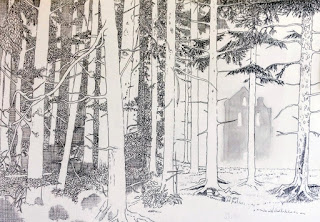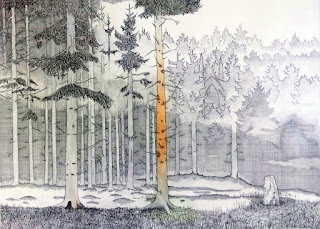Friday, September 22, 2017
St Helena's Chapel - Cape Cornwall
In the latter part of Sketchbook Item (2) mention was made of the numerous sites and remains of chapels attributed to just as many minor saints and solitary religious. This is one such which can be found just north of Land's End in Cornwall about a half mile or so out of St. Just. It is marked on OS Explorer maps.
This drawing was done quite some time ago in the middle of a December gale blowing straight in off the Atlantic. I have memories of sheltering behind a stone wall and making preliminary sketches with hands that were rapidly turning into frozen claws and finally giving up by taking a photo to work from later. The finished piece is about A4 size and as usual on 300 gramme Snowdon cartridge.
As for the claw-like hands; I have a memory of sitting in a café in St. Just with said claws around a cup of steaming Cappuccino and trying not to cry out as feeling returned. Now that is what I call suffering in the name of Art! Then again perhaps not.
Thursday, September 21, 2017
Sketchbook Items (3)
High up on the summit ridge of a Pennine Fell in Northumberland or Cumberland there's a shepherd's cott. In fact they can be found dotted all over the place. Some have found new life as resting places for the grouse-shooting fraternity while others have been restored by the MBA (Mountain Bothies Association) and many more allowed to fall into ruin or even disappear altogether.
The sequence of sketches shown here are of one such in the last category. It no longer exists. The fell featured on the middle right page is where it was , Halton- Lea Fell overlooking the village where I lived nearly forty years ago. So the building shown here is how I imagined it might look having noted the placing of the foundations and the faint path leading to where the door could have been.The cliff is no more than five or six feet high and my guess is the bothy would be a lead-to affair.
Its an interesting little side-project, - another work-in-progress.
Wednesday, September 20, 2017
Sketchbook Items (2)
The Dream of the Rood shown yesterday is only a part of a larger ongoing project made up of several parts.
This double-page spread plus the one below, from the current sketchbook form fragments of a story that's been germinating in my mind for quite some time. A bit of a romantic quasi-legend that looks back towards a long forgotten solitary hermit who lived in a tiny two-roomed cottage deep in the trackless midst of a very ancient forest. It is the changes that the cottage sees is what the sequence of sketches is about; it's coming into being, subsequent decline then veneration as a Holy Site then the forest reclaiming the Site.
Many such ancient ruined or semi ruined chapels can be found all over the remoter parts of the British Isles. Many are marked on Ordnance Survey maps and some are attributed to some sage lost in the mists of antiquity. Needless to say I've made a number of on-site drawings or, if the weather won't permit or for that matter whilst travelling with others, a photograph is taken to work on later. I'm quite fascinated by these little chapels. What was it like living in them? and why were they put there in the first place and for that matter, what is the story behind it all?
Tuesday, September 19, 2017
Sketchbook Items (1)
If I may move away from the "music themed" work for a while I'll post some items from my much-used sketchbook. One idea I'm looking at is the Saxon Writing, "The Dream of the Rood" by an unknown author but has an archaic English translation. What is shown is a concept of a chancel arch based on the one in Jarrow. There is a similar church in Sunderland. Both have connections to the Venerable Bede, a famous 7th. century monk. Whether or not Bede was involved with the poem is uncertain.
Archaeological evidence elsewhere suggests Saxon roods were stone affairs built in to the very structure of the building unlike their mediaeval wooden counterparts. A "rood" is a form of the Christian's cross.
This image is an exploration of the above idea incorporating verses from the "Dream".
The verse I've put into the sketch is shown below.
The choicest vision I do tell
Which came as a midnight dream
I saw a wondrous tree
Borne aloft - wound with light
The brightest of beams.
All was that beacon sprinkled with gold.....
..... All beheld the angel of God
Fair through pre-destiny.
[This] was no malefactor's gallows,
As holy souls beheld it.
I saw the Glory Tree....
Full text etc. here.
Labels:
architecture,
art,
cross,
Dream,
Rood,
Saxon monks,
writings
Monday, September 18, 2017
What was on that Drawing Board
I posted just over a week ago that I would post what can barely be glimpsed in the picture. O.K., - bog standard excuse I know, but its been a busy week. Actually I'm somewhat indisposed just now which gives me more time to be on this rather ancient and consequently slow PC and post an update or two.
So what we have here is the completed line drawing subsequently inked over of "Brahms' German Requiem - Part 1". The actual composition consists of nine parts and my plan is only do two of them before moving on. They are "Selig Sind" (Blessed are they) and "Denn alle Fleisch ist wie Gras und Blümen" (All flesh is like grass and flowers). The theme [Selig sind] looks at those who traverse from darkness, shown here as dense overgrown forest, and through the central area where it thins out to the open ground beyond, though the mist shrouded ruin might well suggest remaining uncertainty. But really I leave the interpretation to you.
Selig sind die da Leid tragen or blessed are they that bear sorrow, a loose translation from the original German, is the title of the finished piece. It is supposed to have a stave of the music beneath it. I will add that later.
As with all of this series, a selected area, in this case the central part, is in full colour fading out to monochrome or greyscale towards the edges of the work. It is my attempt to show the cadences of this particular musical passage. The work is on Fabriano 5 paper at 300 grammes per square metre (gsm) weight and 50 x 35 cms.
Sunday, September 10, 2017
At the Drawing Board
The Artech board that I work from. As can be seen a work is in progress here though it was completed a couple of weeks ago.
I'll show more about this tomorrow.
I'll show more about this tomorrow.
Saturday, September 09, 2017
Bach B minor Mass: - the Drawing.
The title looks like it should read "Bach B minor - the
Movie" but no, its a drawing on 300 gsm cartridge 50 x 70 cm. It is the
finished piece developed from the study sketch, - along with several others, -
shown previously. Close examination should reveal some of the technical drawing
aspects I've used. The German Romantics have played a role here, the painter
David Caspar Friedrich and the composer Robert Schumann as well as my own
interpretation. I spent lot of my time when I was younger walking the more
infrequently visited parts of the Northumberland and Scottish Border areas so
quite naturally, I suppose, such features as coniferous forests, moorland,
standing stones and ancient ruins. I think I've inadvertently walked in
the footsteps of the solitary wanderer featured so much in both the artist's
and musician's footstep to say nothing of the writers such as Goethe and
Schiller. Yes it is all very German and it is my second language to boot.
But
enough of that. Sufficient to say this is a drawing using black ink and micro
pen for the line and the "painterly" component is coloured inks and
brushwork.
The Sanctus in Bach's work has a filigree quality
which I've reflected in the tree-tops and the tall straight tree-trunks
provide the rhythmic bass which could be the huge diapason pipes of the organ.
But let's not get too bogged down in explanations. I'd prefer you to make your own interpretation(s).
Labels:
Caspar Friedrich,
drawing,
German Romantics,
Goethe,
inks.,
Northumberland,
Schille,
Schumann
Thursday, September 07, 2017
A Resurrection of Sorts
This blog has laid dormant for quite some time but finding the capacity to write what may sometimes be lengthy tracts is somewhat limited on Facebook though I will be keeping that page alive nevertheless.
To start the ball rolling again I've posted this image; an A4 sized sketch which is one many sketches done in support of my latest project exploring the link(s) between visual art and music. This isn't a journey into synaesthesia but may well feature some aspects of this. Let's just see how it all pans out.
This is a composite built up listening to the Sanctus from J. S. Bach's B minor Mass. The musical structure emanating from the sound of this piece and the patterns of the notes on the stave suggest, - to me, - the imagery of hidden pinnacles, the point tops of coniferous trees and ancient artefacts such as standing stones and ancient ecclesiastical buildings.The painter David Caspar Friedrich and the composer Robert Schumann's romantic lieder depicting the solitary wanderer come to mind as does the work of J. R. R. Tolkien. But more of that anon in future postings.
To start the ball rolling again I've posted this image; an A4 sized sketch which is one many sketches done in support of my latest project exploring the link(s) between visual art and music. This isn't a journey into synaesthesia but may well feature some aspects of this. Let's just see how it all pans out.
This is a composite built up listening to the Sanctus from J. S. Bach's B minor Mass. The musical structure emanating from the sound of this piece and the patterns of the notes on the stave suggest, - to me, - the imagery of hidden pinnacles, the point tops of coniferous trees and ancient artefacts such as standing stones and ancient ecclesiastical buildings.The painter David Caspar Friedrich and the composer Robert Schumann's romantic lieder depicting the solitary wanderer come to mind as does the work of J. R. R. Tolkien. But more of that anon in future postings.
Subscribe to:
Posts (Atom)










